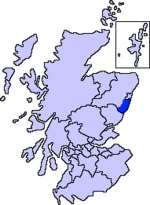Park railway station (Deeside)
1966 disestablishments in ScotlandBeeching closures in ScotlandDisused railway stations in AberdeenshireFormer Great North of Scotland Railway stationsPages with no open date in Infobox station ... and 3 more
Railway stations in Great Britain closed in 1966Railway stations in Great Britain opened in 1853Use British English from March 2019

Park railway station was opened in September 1853 by the Deeside Railway and served the rural area around the Park estate, Nether Sunnyside, West Redford and the hamlet of Park. The Deeside Railway was taken over by the GNoSR and in 1894 nearby Culter became the terminus for the majority of Aberdeen suburban services with only a few trains continuing through Park to Banchory. Despite the 1937 closure of many other stations on the Aberdeen suburban service, Park remained open until 1966 as an intermediate station on the Deeside Railway that ran from Aberdeen (Joint) to Ballater. Park station was located in Drumoak Parish, Aberdeenshire, Scotland.
Excerpt from the Wikipedia article Park railway station (Deeside) (License: CC BY-SA 3.0, Authors, Images).Park railway station (Deeside)
C35K,
Geographical coordinates (GPS) Address Nearby Places Show on map
Geographical coordinates (GPS)
| Latitude | Longitude |
|---|---|
| N 57.0794 ° | E -2.3437 ° |
Address
C35K
AB31 5AF
Scotland, United Kingdom
Open on Google Maps








